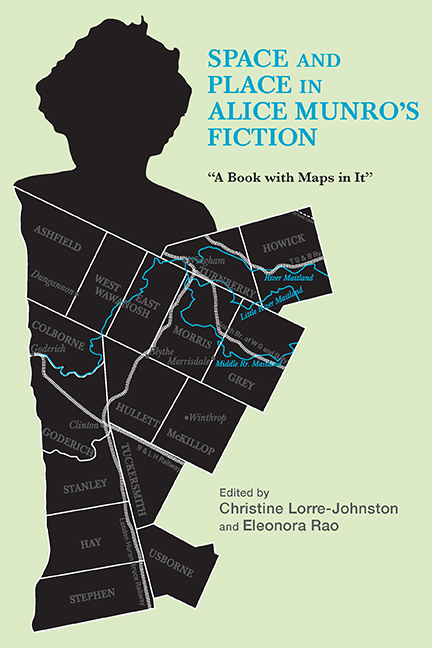Book contents
- Frontmatter
- Contents
- List of Illustrations
- Acknowledgments
- List of Abbreviations
- Introduction
- Part I Conceptualizing Space and Place: Houses, Landscapes, Territory
- 1 Where Do You Think You Are? Alice Munro's Open Houses
- 2 “Whose House Is That?” Spaces of Metamorphosis in Alice Munro's Dance of the Happy Shades, Who Do You Think You Are?, and The View from Castle Rock
- 3 Mapping the Vernacular Landscape in Alice Munro's “What Do You Want to Know For?” and Other Stories
- 4 Stories in the Landscape Mode: A Reading of Alice Munro's “Lives of Girls and Women,” “Walker Brothers Cowboy,” and “Lichen”
- 5 “What Place Is This?” Alice Munro's Fictional Places and Her Place in Fiction
- 6 “The Emptiness in Place of Her”: Space, Absence, and Memory in Alice Munro's Dear Life
- 7 Down the Rabbit Hole: Revisiting the Topos of the Cave in Alice Munro's Short Stories
- Part II Close Readings of Space and Place
- Bibliography
- Notes on the Contributors
- Index
6 - “The Emptiness in Place of Her”: Space, Absence, and Memory in Alice Munro's Dear Life
from Part I - Conceptualizing Space and Place: Houses, Landscapes, Territory
Published online by Cambridge University Press: 15 August 2018
- Frontmatter
- Contents
- List of Illustrations
- Acknowledgments
- List of Abbreviations
- Introduction
- Part I Conceptualizing Space and Place: Houses, Landscapes, Territory
- 1 Where Do You Think You Are? Alice Munro's Open Houses
- 2 “Whose House Is That?” Spaces of Metamorphosis in Alice Munro's Dance of the Happy Shades, Who Do You Think You Are?, and The View from Castle Rock
- 3 Mapping the Vernacular Landscape in Alice Munro's “What Do You Want to Know For?” and Other Stories
- 4 Stories in the Landscape Mode: A Reading of Alice Munro's “Lives of Girls and Women,” “Walker Brothers Cowboy,” and “Lichen”
- 5 “What Place Is This?” Alice Munro's Fictional Places and Her Place in Fiction
- 6 “The Emptiness in Place of Her”: Space, Absence, and Memory in Alice Munro's Dear Life
- 7 Down the Rabbit Hole: Revisiting the Topos of the Cave in Alice Munro's Short Stories
- Part II Close Readings of Space and Place
- Bibliography
- Notes on the Contributors
- Index
Summary
ALICE MUNRO's 2012 COLLECTION, Dear Life, revisits many places familiar from her previous work—mapping both domestic space and the semi-rural landscapes of small town Canada. “In Sight of the Lake,” “Amundsen,” and “Gravel” return to the key image of the lake, while other stories (“To Reach Japan,” “Train”) echo her use of the transitional space of the train in “Wild Swans” (Who Do You Think You Are? / The Beggar Maid, 1978) and “Chance” (Runaway, 2004). Munro territory is by its nature ambiguous and multidimensional. But these later stories are especially marked by silence and absence, evoked by wintry landscapes, empty streets; or the fractured narrative viewpoint associated with memory loss or repression. Munro has declared Dear Life to be her final collection; it is a book that summarizes her career in many ways and, with the autobiographical sequence, “Finale,” closes with a statement of its origins in personal experience.
Bakhtin's well-known concept of the chronotope, the configuration of space and time that characterizes a specific text or genre, both symbolically and structurally, helps us to understand the resonance of landscape and architecture in these stories. Munro uses her characters’ perception of external space to map subjective experience, often locating her characters very precisely in relation to their immediate environment in order to register that which is not seen or not understood or placed at the periphery of the conscious mind. In this chapter I shall focus on the relationship between space, absence, and memory in two stories—“Train” and “Gravel”—the former an example of third-person narration and free indirect discourse, while the latter mimics autobiographical discourse through first-person narration.
Train
“Train,” the story of a drifter in rural Ontario, is a reminder of Munro's debt to Southern Gothic writers, so evident in her first collection, Dance of the Happy Shades (1968). The relationship between the protagonist, Jackson, and Belle, the isolated spinster whose farm he takes over, is especially reminiscent of Flannery O'Connor.
- Type
- Chapter
- Information
- Space and Place in Alice Munro's Fiction“A Book with Maps in It”, pp. 119 - 132Publisher: Boydell & BrewerPrint publication year: 2018



